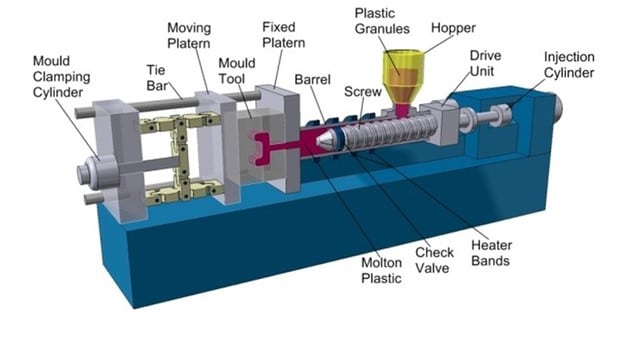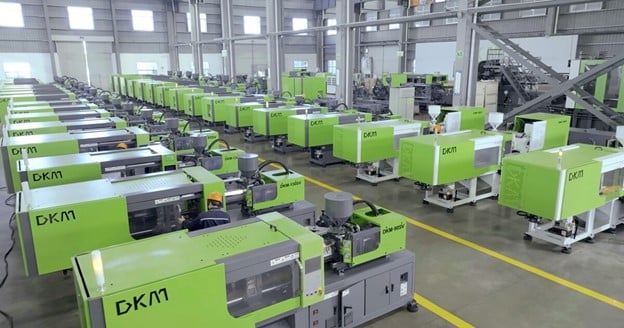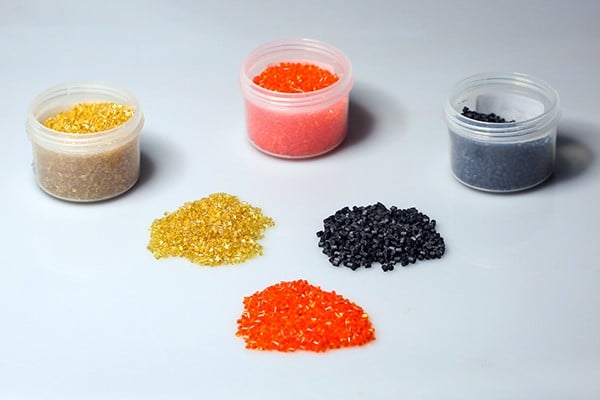Transform your manufacturing process with plastic injection molding machines, versatile pieces of equipment that can revolutionize your operations. These highest quality machines, available from trusted suppliers like Dakumar Machinery, offer exceptional capabilities for producing a wide range of injection molded parts. With an extensive stock and competitive prices, Dakumar Machinery ensures that you have access to the perfect injection molder for your needs.
The injection molding process involves key components such as the injection unit, clamping unit, and injection press. Understanding how these elements work together is essential for achieving superior results. By harnessing the power of injection molding machines, you can manufacture high-quality plastic products, including hearing aid parts and tractor hoods, with precision and efficiency.
When choosing a manufacturing process, consider factors like the types of materials you plan to use, the size of your production run, and the desired price point for your finished products. Injection molding machines offer the flexibility to accommodate various parts and products, providing you with a competitive advantage. Whether you’re working on a small-scale project or a large-scale production run, these machines deliver consistent results within your desired time frame.
By embracing injection molding machines, you can avoid the challenges associated with overseas manufacturing. Eliminate shipping costs, reduce wait times, and gain control over the production process. With U.S.-based companies that possess extensive experience and know-how, you can tap into their expertise and ensure the production of quality plastic parts that contribute to your profitability.
How does plastic injection molding machine operation.
The operation of a plastic injection molding machine involves several key elements and processes. When operating the machine, the molds are positioned horizontally or vertically, depending on the specific requirements of the production. This flexibility allows for a wide range of niche applications and accommodates various production needs.
Insert molding:
One important technique used in plastic injection molding is insert molding. It involves the gravity-based placement of pre-fabricated parts into the mold, which are then fastened securely in place. This technique ensures that the parts remain fixed during the injection process, resulting in accurate and consistent production.
Molds and parts:
To secure the molds and parts, various tools are utilized. These tools include platens, manual clamps, hydraulic clamps, and magnetic clamps. They enable fast tool changes, providing efficiency in the production process. The selection of the appropriate clamping method depends on the design of the mold and the specific requirements of the production.
person designing:
The person designing the mold plays a crucial role in the injection molding process. They carefully consider factors such as the cold runner system or the hot runner system, which determine how the plastic material flows into the mold. The plastic material used may also incorporate fillers to enhance its properties.
Injection unit:
The injection unit of the machine plays a pivotal role in the process. It consists of cavities, channels, a sprue, and cartridge heaters. The plastic material is heated and melted into a liquid form within the barrel. The molten plastic is then injected into the mold through a gate. The clamping pressure ensures that the mold cavity is properly filled, and the appropriate pressure is maintained during the injection process to prevent any material from escaping.
Holding time:
Holding time is crucial in the injection molding process. It is measured in milliseconds or minutes, depending on the specific requirements of the thermoplastic material being used and the complexity of the mold. This holding time allows the material to cool and harden, ensuring that the final product maintains its shape and integrity.
Cooling time:
The cooling time is determined by the type of plastic being used and the desired thickness of the final product. The plastic needs sufficient time to cool down and harden before the mold is opened and the part is ejected. This cooling time is carefully calculated to achieve optimal results.
Types of injection molding machines
Injection molding machines are essential in the production of plastic products. Among the various machine types available, Dakumar Plastic Industrial has gained recognition for its expertise in manufacturing reliable machines. One notable type is the all-electric injection molding machine, which combines mechanical, hydraulic, and electrical components to achieve precise and efficient operation.
toggle system:
The toggle system is a predominant feature in many injection molding machines. It enables the machine to exert the necessary tonnage and clamps with sufficient force to withstand the injection pressure. This system ensures proper molding of the plastic product while minimizing issues like flashing.
Servo-Hydraulic:
Another type of injection molding machine is the Servo-Hydraulic, which combines the features of hydraulic and electric machines. This type operates using electricity and utilizes a hydraulic power source, making it more energy-efficient compared to traditional hydraulic machines. The inclusion of a robotic arm enhances productivity by handling the molded components efficiently.
Different injection molding machine types employ various entry methods for the mold. The side entry, top entry, and drop out methods are commonly used. Additionally, the mold is designed with a chute or container to collect the plastic material as it is injected into the mold cavity.
Hydraulic injection molding:
Hydraulic injection molding machines remain popular due to their durability and cost-effectiveness. These machines are equipped with durable components and provide high clamping force. In contrast, all-electric machines have gained popularity for their energy-efficient operation, as they consume less energy and do not require oil filters, resulting in reduced downtime and maintenance efforts. Furthermore, their digitally controlled systems make them faster and easier to operate.
Hybrid injection molding machine:
The hybrid injection molding machine offers a diverse range of capabilities. It combines the advantages of hydraulic and electric machines, resulting in enhanced energy efficiency and savings. Some models feature a fixed-speed DC pump motor, while others utilize a variable-speed AC motor. This diversity allows manufacturers to choose the best option based on their specific requirements.
How Does An Injection Molding Machine Regulate The Amount Of Plastic Injected?
An injection molding machine is a sophisticated piece of equipment used in the manufacturing process of plastic products. It plays a crucial role in regulating the amount of plastic injected into the mold, ensuring efficient production and minimizing material waste.
At the heart of the injection molding machine is the mold, which serves as a template for shaping the molten plastic into the desired form. The machine is designed to prevent overfilled molds, as this would lead to wasted material and compromised product quality. To achieve precise regulation, the machine employs various mechanisms and components.
The process begins with the plastic material being fed into the machine’s hopper, where it is stored until needed. The hopper is equipped with a feed mechanism that controls the flow of plastic into the machine. A check valve is employed to prevent any backflow, ensuring that the plastic accumulates in the front of the machine.
screw serves a dual purpose:
Once the plastic is in position, it is pushed forward by the injection screw. This screw serves a dual purpose: it both melts the plastic and acts as a piston, forcing it into the mold cavity. The shot volume, or the amount of liquid plastic injected, is carefully monitored to ensure the proper volume is achieved.
During the injection process, the molten plastic fills the mold cavity, taking into account factors such as shrinkage. Shrinkage refers to the slight reduction in size that occurs as the plastic cools and solidifies. The machine compensates for this by injecting a slightly larger volume of plastic to account for the expected shrinkage.
Once the mold cavity is filled, the injection molding machine goes into a holding phase. This allows the plastic to cool and solidify, ensuring the final product’s integrity. The cooling process is critical, as premature ejection of the part could result in deformation or other defects. The machine carefully monitors and controls the cooling process to ensure optimal results. To prevent any excess plastic from bottoming out and causing issues, the injection molding machine regulates the movement of the injection screw and the position of the barrel. This precise control ensures that the right amount of plastic is injected and that the mold cavity is properly filled.
What Materials Are Used For Injection Molding Machines?
Plastic injection molding is a versatile manufacturing process that utilizes various thermoplastics as raw materials. These materials possess specific properties and features that contribute to the production of high-quality final parts and products. Injection molding finds application in a wide range of industries, enabling the creation of diverse products with different functionalities.
ABS (Acrylonitrile Butadiene Styrene):
One commonly used thermoplastic material is ABS (Acrylonitrile Butadiene Styrene). ABS offers exceptional impact resistance and strength, making it an ideal choice for manufacturing automotive body parts, electric outlets, and protective gear. Its versatility allows for the addition of colorants to customize the final product, meeting aesthetic requirements while maintaining structural integrity.
PC (Polycarbonate):
Another popular material is PC (Polycarbonate), known for its lightweight nature and excellent transparency. PC is often used to create clear tubing with high light transmission, making it suitable for applications such as machine guards and tinted windows. Its durability and heat resistance further enhance its usability in various industries.
PE (Polyethylene):
PE (Polyethylene) is a thermoplastic that boasts chemical resistance and flexibility. It finds wide-ranging applications, including indoor applications like toys and food containers. Its ability to withstand different chemicals makes it an excellent choice for manufacturing products that require resistance to various substances.
POM (Polyoxymethylene):
POM (Polyoxymethylene), also known as acetal or Delrin, is a rigid and thermally stable material. Its exceptional stiffness and strength make it ideal for producing firearm frames, knife parts, and system locks. POM exhibits minimal wear and tear, ensuring reliable performance under constant use.
PP (Polypropylene):
PP (Polypropylene) is highly regarded for its high chemical resistance and ability to return to its original shape after deformation. This recyclable material is extensively used in the manufacturing world for storage containers, packages, appliances, and sporting goods. Its chemical resistance and durability ensure long-lasting performance in demanding environments.
PS (Polystyrene):
PS (Polystyrene) is a lightweight and inexpensive material that offers resistance against bacteria and moisture. This characteristic makes it suitable for manufacturing medical supplies, equipment, optical parts, and electronics. PS provides an affordable solution while maintaining the desired properties required for these applications.
TPE (Thermoplastic elastomer):
TPE (Thermoplastic elastomer) is a flexible material that exhibits rubber-like properties. It is less expensive compared to traditional rubber and offers ease of processing. TPE finds applications in various industries, including pet products, footwear, and automotive parts. Its flexibility and durability make it a preferred choice for applications requiring resilience and resistance to extreme temperatures and chemicals.
TPU (Thermoplastic polyurethane):
TPU (Thermoplastic polyurethane) is a rubber-like plastic known for its elasticity and resistance to extreme temperatures and chemicals. It is commonly used in the production of gaskets, closures, enclosures, sporting goods, and medical devices. TPU provides a versatile solution for applications that demand flexibility and durability.
What Are The Benefits Of Plastic Injection Molding?
Plastic injection molding machine offers numerous benefits in various aspects of the manufacturing process. It enables efficient high-volume production by leveraging the high speed and automation capabilities of the process. With plastic processing and manufacturing, a wide variety of materials can be utilized, allowing for the production of products and parts with diverse properties. The versatility extends to the use of different colors and finishes, enhancing the aesthetic appeal of the final products.
High precision and tight tolerances:
One of the key advantages of plastic injection molding is its ability to achieve high precision and tight tolerances. This makes it suitable for creating intricate designs with consistent results. The process involves the use of advanced mold design and injection press technology, ensuring the size and thickness of the products meet the desired specifications. Injection screws enable the precise control of the material consistency during the manufacturing process, contributing to superior quality control.
Efficiency and minimal waste:
Plastic injection molding is particularly advantageous for large volume runs due to its efficiency and minimal waste. Any waste plastic generated during production can be remelted and reinjected, minimizing material wastage. This makes it a cost-effective option, especially for long runs or multiple runs. The per-piece price of the final products decreases significantly for large runs, making it a favorable choice for businesses aiming to optimize their manufacturing costs.
Cost efficiency:
The benefits of plastic injection molding extend beyond cost efficiency. The process allows for efficient high production with fast cycle times, making it suitable for medium to high-volume production runs. Multi-cavity molds and family molds further enhance the manufacturing rate, enabling the production of identical products with high tolerances and reliability.
Wide range of material choices:
Another advantage is the wide range of material choices available for plastic injection molding. From various plastic materials to liquid silicone rubber molding, the process accommodates different fillers, offering increased strength and flexibility in design. The ability to incorporate different colors into the molten plastic allows for vibrant and visually appealing products. Additionally, the process produces low waste and supports recycling efforts, contributing to sustainability.
Complex shapes:
Plastic injection molding enables the production of products with high detail and complex shapes. The molten plastic is injected into the mold at high pressure, ensuring the replication of intricate shapes and details with precision. Post-processing and post-production options are available to further enhance the aesthetics of the products, such as adding special finishes, logos, or engraved text.
FAQs.
- How expensive is an injection molding machine?
we can conclude that the cost of an injection molding machine can vary significantly. Simple molds, which are typically cheaper, can range from $3,000 to $6,000. On the other hand, larger, more complex, high-production, or multi-cavity molds can be considerably more expensive, costing $25,000 to $50,000 or even more. Therefore, the expense of an injection molding machine depends on factors such as the size, complexity, and production capacity required.
- Is plastic injection molding profitable?
Plastic molding is described as a potentially profitable industry. This indicates that plastic injection molding has the potential to be profitable. However, it is important to note that profitability is not guaranteed and there may be challenges associated with the industry. Factors such as competition, market conditions, and operational efficiency can significantly impact the profitability of plastic injection molding businesses. Therefore, while there are opportunities for profitability, it is necessary to carefully assess various factors before determining the actual profitability of a specific plastic injection molding operation.
- How long do injection molding machines last?
The lifespan of injection molding machines can vary depending on several factors. In the provided content, it mentions that plastic injection molds can last from hundreds to over a million cycles. This suggests that the longevity of injection molding machines is closely tied to the lifespan of the molds they use.
However, it’s important to note that the lifespan of an injection molding machine is not solely determined by the molds. Factors such as the machine’s environment, maintenance practices, structure, SPI classification (which refers to the Society of the Plastics Industry classification system), and other variables also play a role.






